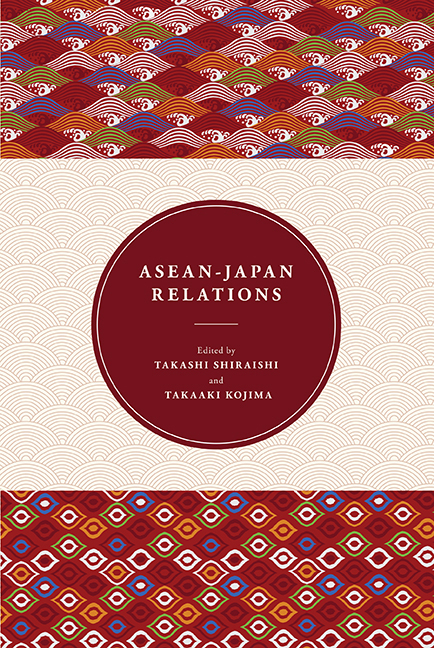Book contents
- Frontmatter
- Contents
- Preface
- About the Contributors
- 1 An Overview of Japan-ASEAN Relations
- 2 Japan's Relations with ASEAN
- 3 Approaches toward Regionalism: Japan, China and the Implications on ASEAN
- 4 The New Japan-ASEAN Partnership: Challenges in the Transformation of the Regional Context in East Asia
- 5 ASEAN-Japan Strategic Partnership and Regional Integration: Impacts and Implications
- 6 ASEAN-Japan Cooperation on Maritime Non-Traditional Security Issues: Toward a New Paradigm
- 7 Japan's Evolving Security Concerns in Maritime Southeast Asia: From Safety of Navigation to “Lake Beijing”
- 8 Evolution of Institutions and Policies for Economic Integration in East Asia: The Rise of China and Changes in the Regional Order
- 9 Managing Integration in East Asia: Behind Border Issues in Japan-ASEAN Trade Agreements
- 10 Regional Financial Cooperation in East Asia: Development and Challenges
- 11 Japanese Development Assistance to ASEAN Countries
- 12 Japanese Foreign Direct Investment in the ASEAN-4 Countries
- 13 Japan's Triple Tsunami
- 14 ASEAN-Japan Relations: A Singapore Perspective
4 - The New Japan-ASEAN Partnership: Challenges in the Transformation of the Regional Context in East Asia
Published online by Cambridge University Press: 21 October 2015
- Frontmatter
- Contents
- Preface
- About the Contributors
- 1 An Overview of Japan-ASEAN Relations
- 2 Japan's Relations with ASEAN
- 3 Approaches toward Regionalism: Japan, China and the Implications on ASEAN
- 4 The New Japan-ASEAN Partnership: Challenges in the Transformation of the Regional Context in East Asia
- 5 ASEAN-Japan Strategic Partnership and Regional Integration: Impacts and Implications
- 6 ASEAN-Japan Cooperation on Maritime Non-Traditional Security Issues: Toward a New Paradigm
- 7 Japan's Evolving Security Concerns in Maritime Southeast Asia: From Safety of Navigation to “Lake Beijing”
- 8 Evolution of Institutions and Policies for Economic Integration in East Asia: The Rise of China and Changes in the Regional Order
- 9 Managing Integration in East Asia: Behind Border Issues in Japan-ASEAN Trade Agreements
- 10 Regional Financial Cooperation in East Asia: Development and Challenges
- 11 Japanese Development Assistance to ASEAN Countries
- 12 Japanese Foreign Direct Investment in the ASEAN-4 Countries
- 13 Japan's Triple Tsunami
- 14 ASEAN-Japan Relations: A Singapore Perspective
Summary
INTRODUCTION
The Japan-ASEAN (Association of Southeast Asian Nations) partnership has a long history, beginning in the early 1970s. Japan began to have an informal dialogue with ASEAN in 1973 in order to resolve trade frictions over synthetic rubber. Prime Minister Takeo Fukuda proposed the Fukuda Doctrine and stressed the necessity of “heart-to-heart”, “person-to-person” understanding when he was invited to the second ASEAN Summit in Kuala Lumpur in August 1977. Japan played an important role in the process of trying to find a resolution to the prolonged internal conflict in Cambodia, and contributed to reconstructing the country. After the 1997–98 Asian Financial Crisis, Japan's presence was evident in the various projects and plans to help crisis-hit countries overcome their problems as well as revitalize their economies. For example, the New Miyazawa Plan (1998), which was a package of financial assistance directed toward Thailand, Malaysia, the Philippines, the Republic of Korea (ROK), and Indonesia, was financed by Japan. In the early 1990s, Japan and ASEAN institutionalized the Meeting of ASEAN Economic Ministers and Minister for International Trade and Industry (AEM-MITI). AEM-MITI focused on economic cooperation between ASEAN and Japan, including assistance for Indochina (Vietnam, Cambodia, and Lao PDR) and Myanmar, with the aim of supporting these countries’ aspirations to be members of ASEAN. In addition, economic ministers of ASEAN countries and Japan agreed to establish the Cambodia-Laos-Myanmar Working Group, which aimed at narrowing the developmental gap in Southeast Asia, at the AEMMITI meeting held in September 1994. ASEAN economic cooperation actually began with an agreement between ASEAN economic ministers in 1992 to establish the ASEAN Free Trade Area (AFTA). After this, Japan-ASEAN industrial cooperation started encouraging greater integration and development in Southeast Asia. The Japan-ASEAN partnership carried a heavy weight for ASEAN countries because of Japan's position as the second-largest economic power in the world.
However, several new trends in East Asia since the beginning of the 21st century led Japan to rethink and reconstruct the Japan-ASEAN partnership. The rise of China, the acceleration of ASEAN integration, and the rapid development of ASEAN-centered regional architecture transformed economic circumstances in East Asia. These trends are interconnected with each other and have transformed the regional economic landscape of East Asia, significantly changing the character of the Japan-ASEAN partnership.
- Type
- Chapter
- Information
- ASEAN-Japan Relations , pp. 55 - 72Publisher: ISEAS–Yusof Ishak InstitutePrint publication year: 2013

